"Yellow f***ing Lamborghini!"
I've been spotted. I'm trying to change my boots as inconspicuously as I possibly can in the parking lot next to the ski lift, but when you're perched on the door sill of a Huracan Sterrato, a shiny yellow beacon in a field of filthy gray SUVs, there's no hiding.
A young man on skis is losing his mind a short distance away, issuing the profanity-laced call to his friends to come to take a look at the bright wedge in the icy lot, and I know it's going to be a few extra minutes before I make it to the lift.
You can't fault their excitement. Southern Vermont is unlikely Lamborghini territory at the best of times. In mid-January? Forget about it. You might see a brave Carrera 4, but that's about as exotic as it gets this time of year in the Green Mountains.
In January, the hope is always that those mountains will be white. The roads, though, were in quite a state: muddy and icy and sloppy, and the perfect testing ground for this oddball supercar.

Lamborghini showed its intent with the 2019 Sterrato concept, but it wasn't until mid-2022 that the company confirmed they'd actually build the thing.
On paper, that thing doesn't seem so special. A paltry 44 mm of lift does not a rally car make, nor 30 and 34 mm of additional track at the front and rear, respectively, nor the bolted-on fender flares and questionably functional skid plates.
But, as Brett Berk learned when he drove it through the desert, minor updates on paper can create fantastic cars. I planned for a test of a different sort, to pilot this delightful beacon across the winding and filthy roads of Upstate New York and Southern Vermont toward one of my favorite mountains.
The car you see here, which Lamborghini provided for a long weekend, came complete with numerous options, the most significant (and worthwhile) being the $9,800 for the Giallo Inti paint. Total price? That would be $348,649 including the $3,695 destination charge and $2,100 gas guzzler tax – a lot of money for a winter beater.
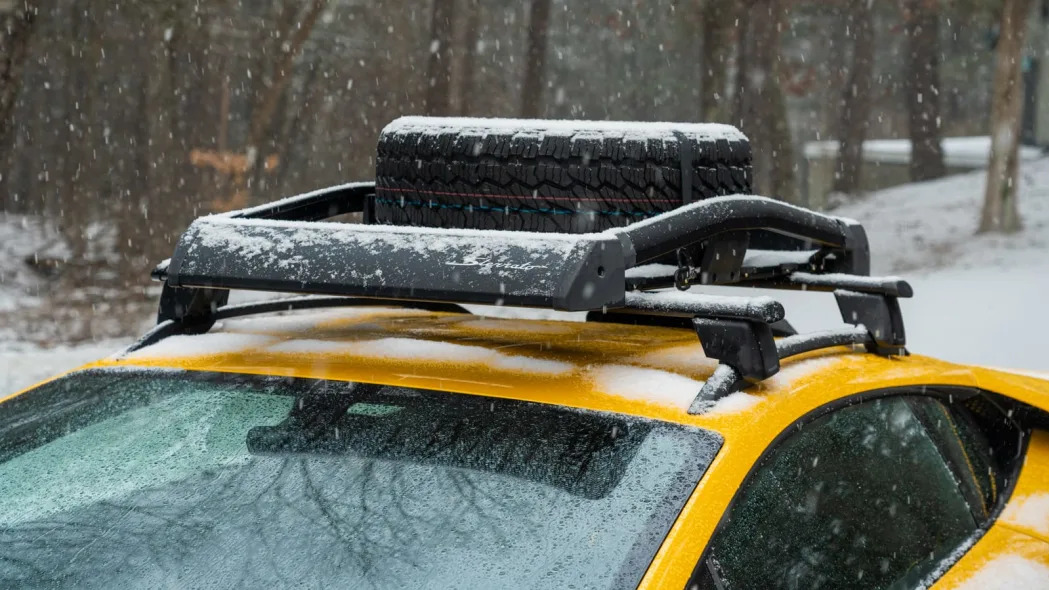
One of those options, though, threatened to stymie the trip before I even got out of my driveway.
The accessory roof basket and the spare wheel Lamborghini attached to it using the included “wheel retainer belt” gives the Sterrato a certain stance and character. However, it created some challenges. I had initially planned on using my SeaSucker mount to simply stick my board on the roof and head for the hills. There was no room.
I then planned to remove the basket, which slides onto the also-optional crossbars attached to the standard raised roof rails. Sadly, the basket was locked in place with the keys nowhere to be found. Hmm, probably should’ve phoned ahead and asked for the accessory roof ski and snowboard rack. Oh well.
Next plan: Just strap the board to the basket. It’s small but quite well designed, with rubberized edges that, with a few ratchet straps, would have held my board quite securely. Sadly, I was forbidden from actually putting anything in (or on) that basket.
That left just one final option: Put the damn thing in the car. Slotting a 5.35-foot plank with sharp, metal edges into an ornate interior of Alcantara and carbon fiber wasn't top on my list. So, I wrapped my snowboard up like a big burrito in a moving blanket and, with a little delicate maneuvering, managed to angle it from the passenger footwell up between the seats. I buckled it in using the blazing Giallo seatbelt, and away we went.
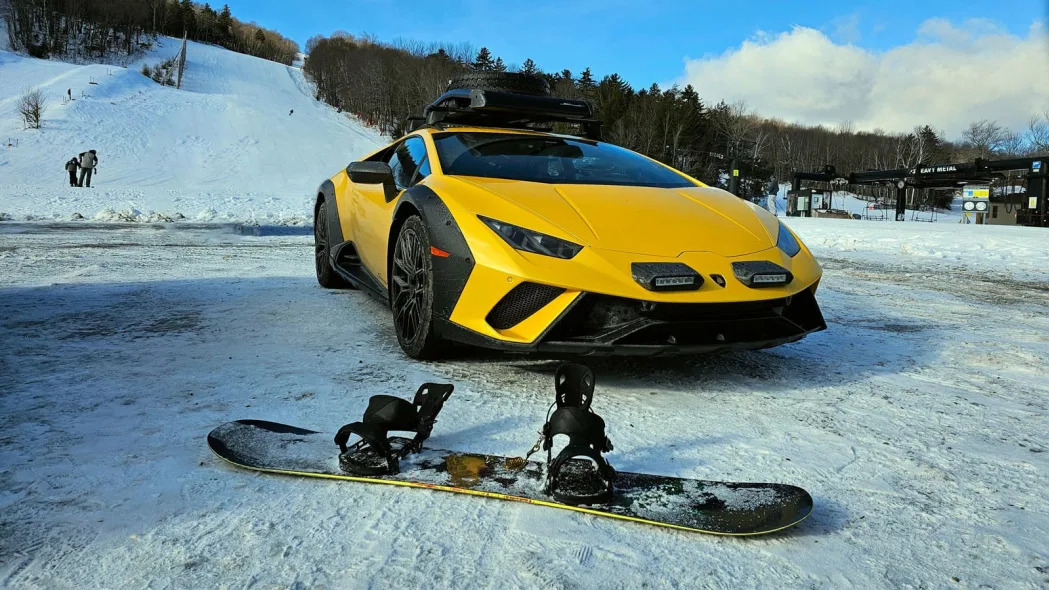
That interior hasn't seen any major updates for off-road Sterrato duty. The biggest change is a pair of custom-labeled, nicely fitting rubber floor mats. While not expansive, the Huracan's interior is relatively roomy (though definitely not enough headroom for your winter beanie with the jaunty pom-pom).
The overall design is busy but racy, though perhaps getting a bit familiar at this point. Thankfully, a recent update added niceties like Android Auto and Apple CarPlay. They're wired, but that's better than nothing. Dig into the car's interface, though, and you'll find a few small Sterrato-specific add-ons, like an inclinometer screen with GPS coordinates.
The most significant change within the Sterrato is hiding on the bottom of the button-heavy steering wheel. On lesser Huracans, you can toggle from Strada to Sport and then on to Corsa.
Here, that last mode is replaced by Rally, designed to allow for more wheelspin, more aggressive torque vectoring, and more grins.
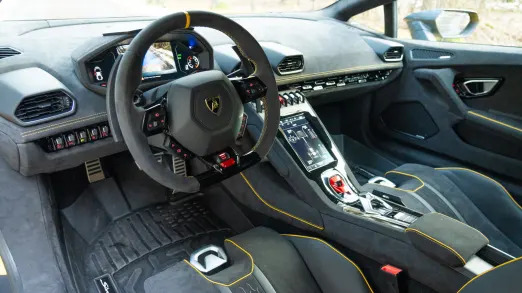

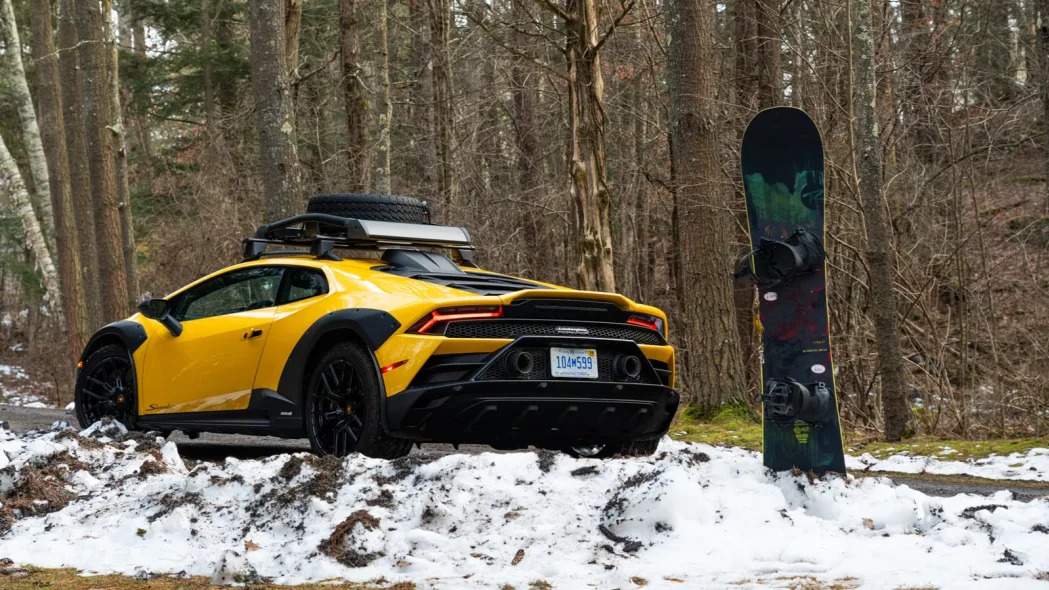
To see how well all three modes fare in snowy conditions, I hit the road early with my best board by my side and an air of excitement all around me. The sun wasn't up yet, but while the off-road aux lights on the nose seem mostly for show, the Huracan's on-road lights are brilliant at cutting through the sort of inky blackness only found on rural, tree-lined streets.
I was less impressed by the absence of heaters for the seats or steering wheel. I wouldn't normally ding a Lambo for this omission, but then Lamborghinis don't normally come on tires rated for mud and snow, and it's no fun testing out the latter half of that rating with a cold kiester.
Nineteen-inch Bridgestone Dueler AT002 tires are standard, 235/40 at the front and 285/40 at the rear. Though they carry the M+S rating, they are definitely more suited for M. Still, they did fine in light snow and overall were great on the grimy, dirty roads that are far more common this time of year. They offered solid grip and, more importantly, predictable behavior when that grip ran out.
Still, if this is the kind of adventure you're lucky enough to embark on, I'd recommend you fit yourself a proper set of winter tires. (The Bridgestone Blizzak LM005 is the official Sterrato choice, and a fine one at that.)
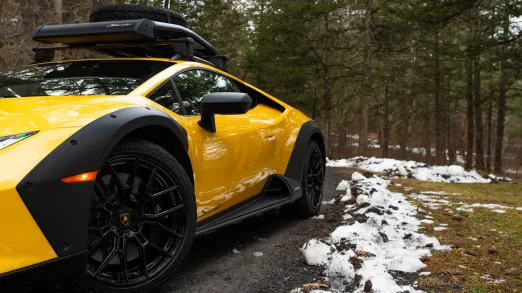
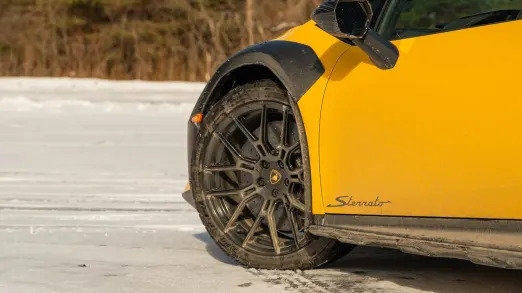
Another pro tip: Ditch the spare wheel on the roof. Yes, it looks cool, but it not only left me with a snowboard sitting shotgun, the basket and wheel combo means mondo wind noise above 40 mph. Worse, the manual says the basket’s max speed is 80 mph. In a Lamborghini. If it served a purpose, that might be acceptable, but without a tire jack, its utility is questionable. That’s right, since the spare wheel is not included with the car, neither is a tire jack. You can of course get one separately and drop it in the frunk, but at a mere 3.53-cubic-feet of volume, that doesn’t let you pack a whole lot on your ski weekend. Compromise? Get the wheel to look cool in the summer and remove it in the winter for some combo of ski rack and cargo box. You have the money.
And I'll get one final annoyance out of the way before I begin the gushing praise: rearward visibility. The Sterrato comes with a roof-mounted intake to feed the 5.2-liter V10. This would look delightful were it not hiding under the basket. It's ostensibly designed to pull less dirt into the motor as you're bombing through the fech fech.
It is far more effective at blocking any view of anything behind. Mephistopheles himself could be tailgating you in a lifted F-650 with a set of infernal lights on high beam, and you'd be absolutely none the wiser. The rear camera makes backing up possible, but a digital rearview mirror would have been better.
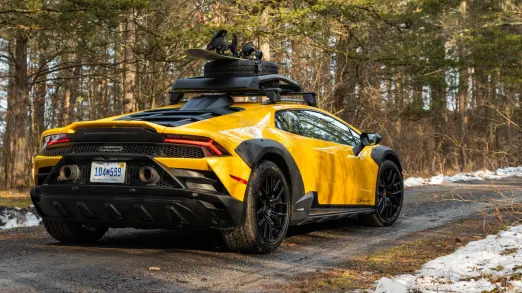

Once I got into Vermont, as the roads started to climb and the traffic cleared, those minor concerns faded away. Like on the regular Huracan, Strada mode is far too tame for anything but sleepy commuting. It up-shifted through the Sterrato's seven-speed dual-clutch transmission early and often, chopped the V10 down to an inline-five whenever it could, and delivered an relatively impressive 15.1 mpg.
I was more interested in smiles, and Sport mode definitely delivers, while Rally is properly manic. My biggest disappointment with Porsche's 911 Dakar was that its Rally mode still brings in the traction and stability control early and often. That is not a problem with the Sterrato. The Lambo will cut power if your countersteering gets overly severe, but otherwise, it's happy to let all four wheels spin and chew up the ice and snow with wild abandon.
I spent a lot of time covering roads with uneven coatings of snow and ice, patches here and there fallen from trees or shaded from the sun. Yet even as I accelerated too hard with only one or two wheels on the ice, the Sterrato always stayed pointed in the right direction, needing only a minor correction.
Flooring a 602-horsepower car when the right two tires are on ice should be a one-way ticket to the closest ditch. With the Sterrato, I just needed to add a little left steering, and away we went.
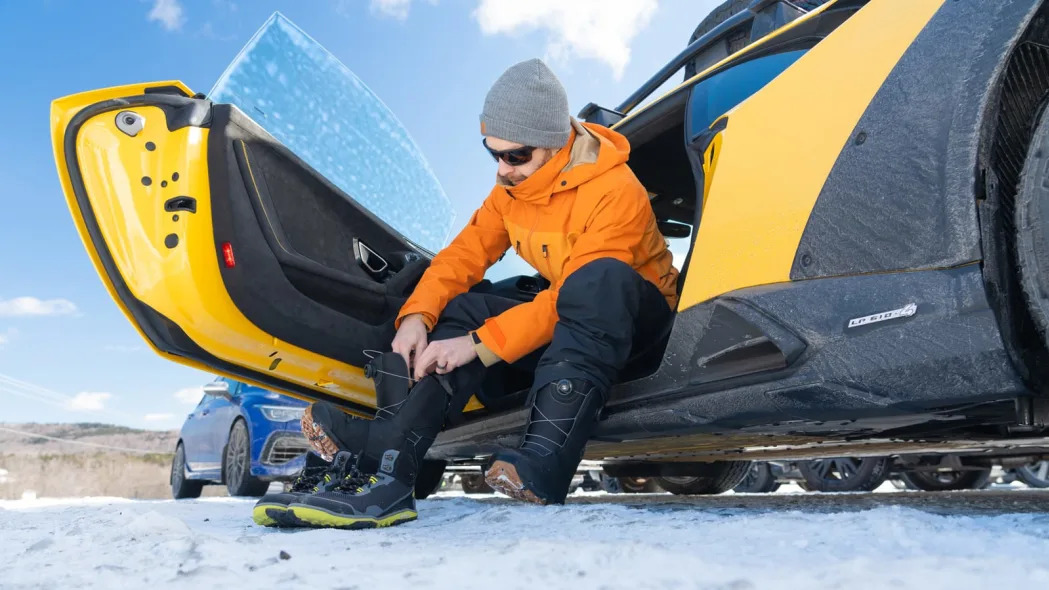
Watching the car's display, I could see the differentials locking and shifting power front-to-back, side-to-side, doing just what I wanted. It never felt boringly planted, but neither did it feel nervous and wicked. It's a driving experience I'd gladly repeat all winter long.
But only if I weren't paying. As I washed the worst of the road grime from the thing at the end of my time with it, I shuddered, thinking about what all that salt would eventually do.
But cars are meant to be driven and driven hard, and uneven winter conditions are among the hardest of all. That the Sterrato not only survived but excelled despite only a few tweaks from the base car says everything you need to know about how good the Huracan still is.
Oh, and how were the slopes? The wide sills of the Huracan made for a surprisingly good bench as I tightened my snowboard boots, and while extracting and unwrapping my board itself was a bit of a challenge (especially with a small cadre of wide-eyed lookers on), both the trip there and the actual process of getting ready to ride were a breeze. The Sterrato was comfortable, compliant, and an utter joy. Given the chance, I'd do it all over again tomorrow.
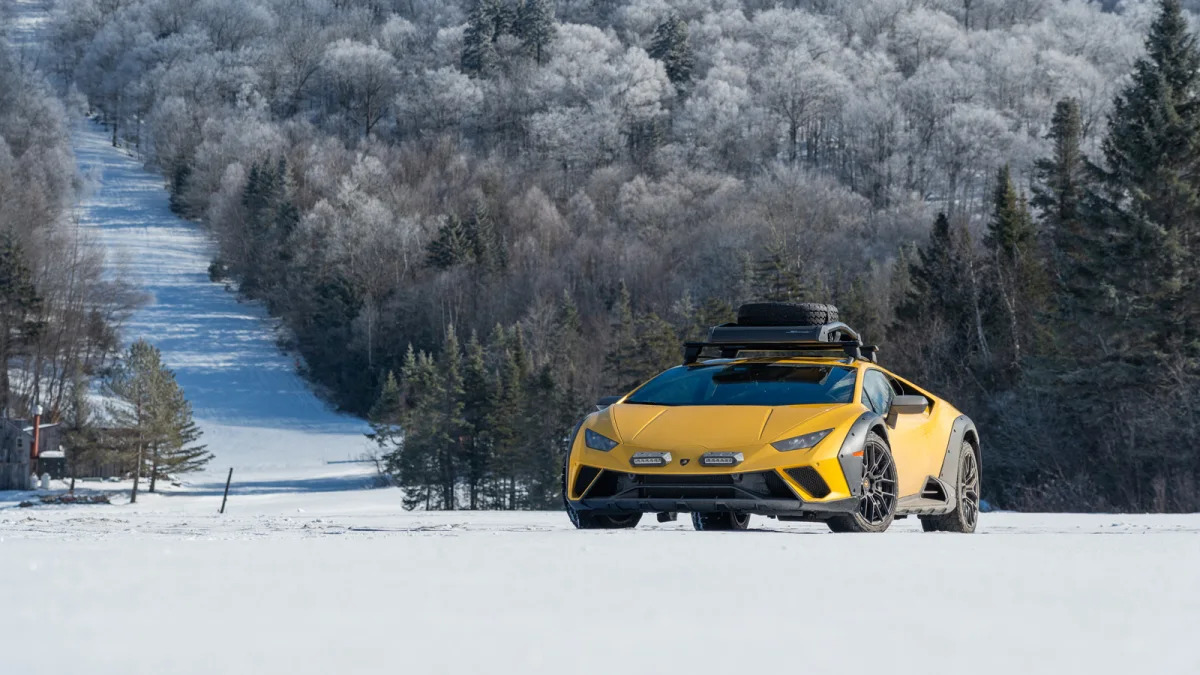








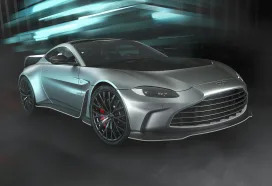

Sign in to post
Please sign in to leave a comment.
Continue